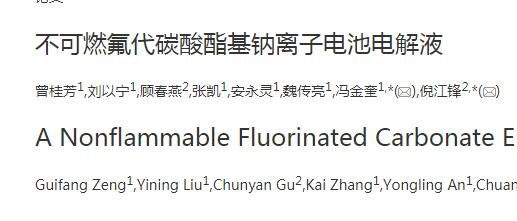摘要:
锂离子电池由于其较高的能量密度而在我们的日常生活中被广泛使用,比如手机、笔记本电脑和电动汽车。然而,地球上有限的锂资源可能会阻碍其进一步的发展。近来,由于丰富的资源、合适的电化学平台和低廉的价格,钠离子电池正得到大家越来越多的关注,有希望成为下一代主流储能体系。然而,跟锂离子电池类似,钠离子电池的电解液主要是由易燃的有机碳酸酯或醚类溶剂、钠盐和一些添加剂组成,这就带来了安全隐患。此外,钠金属具有比锂更高的化学活性,导致钠离子电池可能具有比锂离子电池更大的危险性。为了解决这个安全性问题,我们提出一种不可燃的氟代碳酸酯基电解液。电解液成分是由0.9 mol∙L−1 NaPF6溶解在氟代碳酸乙烯酯(FEC)和二-2, 2, 2-三氟乙基碳酸酯(DTFEC) CAS:1513-87-7 (3 : 7,体积比)混合溶剂中组成。测试结果表明,该电解液体系不仅具有优异的阻燃能力,而且与钠离子电池的正负极都具有很好地相容性。在此电解液中,普鲁士蓝正极时表现出色的电化学性能,循环50圈后,仍有84 mAh∙g−1的容量。此外,商业化硬碳材料在该电解液中也表现出了较好的电化学性能。这项工作可能为开发下一代安全型钠离子电池提供新途径。
关键词: 氟代碳酸乙烯酯, 不可燃电解液, 钠离子电池, 二-2, 2,2-三氟乙基碳酸酯
Abstract:
Lithium-ion batteries (LIBs) are widely used in cellphones, laptops, and electric cars owing to their high energy density and long operational lifetime. However, their further deployment in large-scale energy storage systems is restricted by the uneven distribution of lithium resources (~0.0017% (mass fraction, w) in the Earth's crust). Therefore, alternative energy storage systems composed of abundant elements are of urgent need. Recently, sodium-ion batteries (SIBs) have attracted significant attention and are considered to be a potential alternative for next-generation batteries owing to abundant sodium resources (~2.64% (w) of the Earth's crust), suitable potential (−2.71 V), and low cost. SIBs are similar to LIBs in terms of their physical and electrochemical properties. Previous studies have mainly focused on SIB storage materials, including hard carbon, alloys, and hexacyanoferrate, while the safety of SIBs remains largely unexplored. Similar to LIBs, the current electrolytes used in SIBs are mainly composed of flammable organic carbonate solvents (or ether solvents), sodium salts, and functional additives, which pose possible safety issues. Moreover, the chemical activity of sodium is much higher than that of lithium, leading to a higher risk of fire, thermal runaway, and explosion. To overcome this problem, herein we propose a fluorinated non-flammable electrolyte composed of 0.9 mol∙L−1 NaPF6 (sodium hexafluorophosphate) in an intermixture of di-(2, 2, 2 trifluoroethyl) carbonate (TFEC) and fluoroethylene carbonate (FEC) in a 7 : 3 ratio by volume. Its physical and electrochemical properties were studied by ionic conductivity, direct ignition, cyclic voltammetry, and charge/discharge measurements, demonstrating excellent flame-retarding ability and outstanding compatibility with sodium electrodes. The electrochemical tests showed that the Prussian blue cathode retained a capacity of 84 mAh∙g−1 over 50 cycles in the prepared electrolyte, in contrast to the rapid capacity degradation in a flammable conventional carbonate electrolyte (74 mAh∙g−1 with 57% capacity retention after 50 cycles). To test the practical application of the proposed electrolyte, a hard carbon anode was used and exhibited exceptional performance in this system. The enhancement mechanism was further verified by Fourier transform infrared (FTIR), X-ray diffraction (XRD), and scanning emission microscopy (SEM) investigations. Polycarbonate on the surface of the cathode played an important role for the studied electrolyte system. The polycarbonate may originate from FEC decomposition, which can enhance the ionic conductivity of the solid electrolyte interface (SEI) layer and reduce impedance. Hence, we believe that this proposed electrolyte may provide new opportunities for the design of robust and safe SIBs for next-generation applications.
Key words: Fluoroethylene carbonate, Non-flammable electrolyte, Sodium-ion battery, Di-2, 2, 2-trifluoroethyl carbonate


